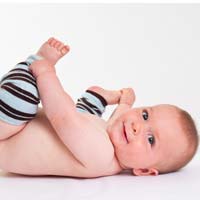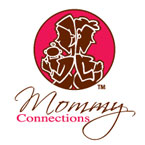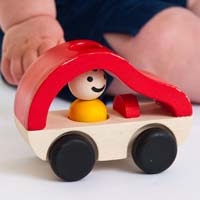Top parenting stories this week
Stages of Baby Development

In This Article

Baby Development Chart
Some children need more encouragement in one area of development than another. Although it's important to focus on all areas mentioned above, tracking your baby's developmental milestones can help you assess your child. "You can see where your child may be having a few challenges, and you can stimulate her accordingly," says Cooper. Here's our baby development chart:
By 4 months your baby should:
- Track an object from side-to-side
- Turn head toward a familiar voice
- Make sounds when looking at toys or people
- Respond by making cooing sounds and moving arms and legs
- Laugh and smile at you
- Lift head and support self on forearms
- Bring both hands to chest when lying on back
- Hold head steady when supported in a sitting position
- Reach for an object when supported in a sitting position
- Hold an object briefly when placed in hand
- Make eye contact
By 6 months your baby should:
- Follow a moving object with eyes
- Look in the direction of a new sound
- Respond to his or her name
- Smile and babble when given adult attention
- Vocalize pleasure and displeasure (squeal with excitement or grunt in anger)
- Have a conversation by babbling with you
- Roll from back to stomach or stomach to back
- Push up on hands when on tummy
- Sit with support
- Use hands to reach, grasp, bang and splash
- Bat or hit objects
- Bring hands or toy to mouth
- Pat and pull at your hair, glasses and face
- Sleep and feed at regular times
- Recognize familiar people
By 9 months your baby should:
- Look for a hidden toy
- Imitate facial expressions
- Turn to look for a source of sound
- Understand short instructions
- Babble a series of different sounds
- Make sounds to get attention
- Sit without support for a few minutes
- Attempt to move by crawling, bum shuffling or pivoting on tummy
- Pull up to standing position and stand with support
- Pass an object from one hand to the other
- Pick up small items using thumb and first finger
- Put small items in mouth
- Bang two objects together
- Have a special smile for familiar adults
- Reach to be picked up or held
- Drop items on purpose
- Look for items when dropped
By 12 months your baby should:
- Look at a person who is saying their name
- Understand simple requests and questions
- Chatter to toys or people using three different sounds
- Take turns making sounds with you
- Imitate non-speech sounds
- Hold, bite and chew crackers
- Get into sitting position without help
- Crawl or bum shuffle with ease
- Walk holding your hands or furniture
- Pick up small items using tips of thumb and first finger
- Take items out of a container
- Show many emotions such as affection, anger, joy or fear
- Initiate games such as pat-a-cake or peek-a-boo with you
- Seek comfort
- Use facial expressions, actions and sounds to make needs known or to protest
- Wave good-bye
- Look at a book
- Begin to roll a ball
Meet our experts:
Pam Schiller is a freelance early childhood consultant and author of numerous books including: The Complete Resource Book For Infants. She served as the head of the Early Childhood Department at the University of Houston and is the senior author of DLM Early Childhood Express.
Dr. Carol Cooper is a family doctor and mother of three boys. She is the author of numerous journal articles and books including: Your Clever Baby and Baby Milestones: Stimulate Development from 0-3 years.








